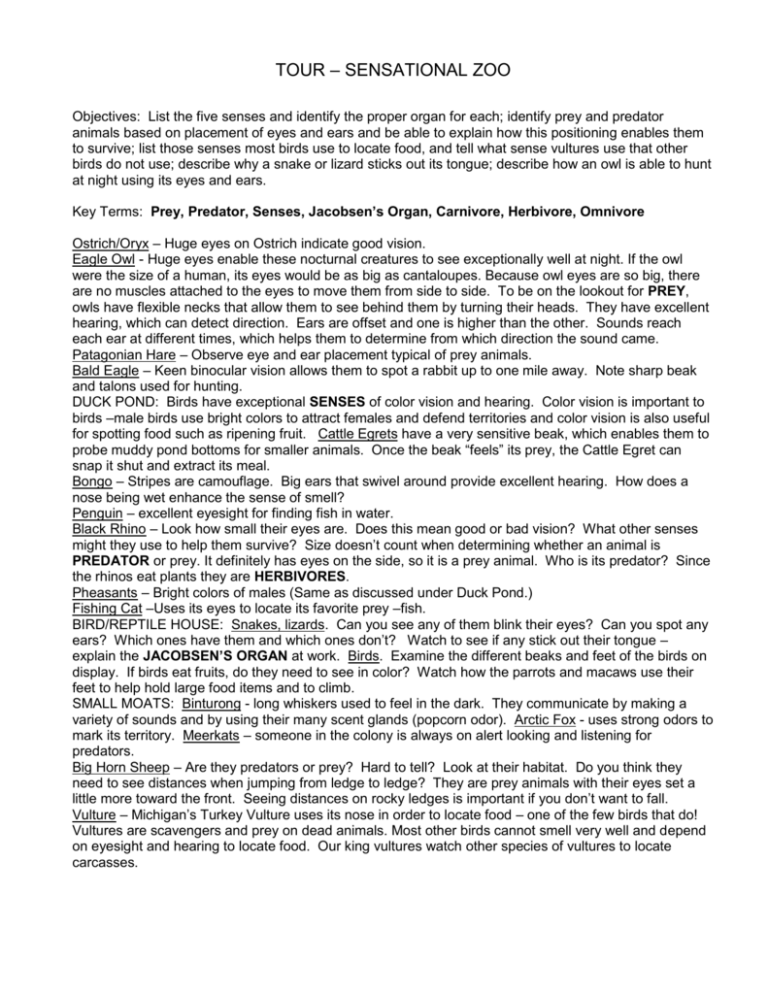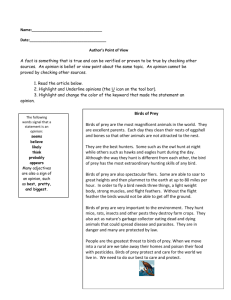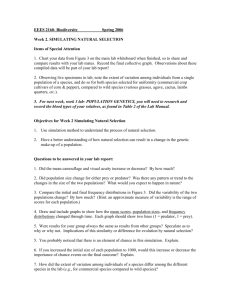Sensational Zoo Tour
advertisement

TOUR – SENSATIONAL ZOO Objectives: List the five senses and identify the proper organ for each; identify prey and predator animals based on placement of eyes and ears and be able to explain how this positioning enables them to survive; list those senses most birds use to locate food, and tell what sense vultures use that other birds do not use; describe why a snake or lizard sticks out its tongue; describe how an owl is able to hunt at night using its eyes and ears. Key Terms: Prey, Predator, Senses, Jacobsen’s Organ, Carnivore, Herbivore, Omnivore Ostrich/Oryx – Huge eyes on Ostrich indicate good vision. Eagle Owl - Huge eyes enable these nocturnal creatures to see exceptionally well at night. If the owl were the size of a human, its eyes would be as big as cantaloupes. Because owl eyes are so big, there are no muscles attached to the eyes to move them from side to side. To be on the lookout for PREY, owls have flexible necks that allow them to see behind them by turning their heads. They have excellent hearing, which can detect direction. Ears are offset and one is higher than the other. Sounds reach each ear at different times, which helps them to determine from which direction the sound came. Patagonian Hare – Observe eye and ear placement typical of prey animals. Bald Eagle – Keen binocular vision allows them to spot a rabbit up to one mile away. Note sharp beak and talons used for hunting. DUCK POND: Birds have exceptional SENSES of color vision and hearing. Color vision is important to birds –male birds use bright colors to attract females and defend territories and color vision is also useful for spotting food such as ripening fruit. Cattle Egrets have a very sensitive beak, which enables them to probe muddy pond bottoms for smaller animals. Once the beak “feels” its prey, the Cattle Egret can snap it shut and extract its meal. Bongo – Stripes are camouflage. Big ears that swivel around provide excellent hearing. How does a nose being wet enhance the sense of smell? Penguin – excellent eyesight for finding fish in water. Black Rhino – Look how small their eyes are. Does this mean good or bad vision? What other senses might they use to help them survive? Size doesn’t count when determining whether an animal is PREDATOR or prey. It definitely has eyes on the side, so it is a prey animal. Who is its predator? Since the rhinos eat plants they are HERBIVORES. Pheasants – Bright colors of males (Same as discussed under Duck Pond.) Fishing Cat –Uses its eyes to locate its favorite prey –fish. BIRD/REPTILE HOUSE: Snakes, lizards. Can you see any of them blink their eyes? Can you spot any ears? Which ones have them and which ones don’t? Watch to see if any stick out their tongue – explain the JACOBSEN’S ORGAN at work. Birds. Examine the different beaks and feet of the birds on display. If birds eat fruits, do they need to see in color? Watch how the parrots and macaws use their feet to help hold large food items and to climb. SMALL MOATS: Binturong - long whiskers used to feel in the dark. They communicate by making a variety of sounds and by using their many scent glands (popcorn odor). Arctic Fox - uses strong odors to mark its territory. Meerkats – someone in the colony is always on alert looking and listening for predators. Big Horn Sheep – Are they predators or prey? Hard to tell? Look at their habitat. Do you think they need to see distances when jumping from ledge to ledge? They are prey animals with their eyes set a little more toward the front. Seeing distances on rocky ledges is important if you don’t want to fall. Vulture – Michigan’s Turkey Vulture uses its nose in order to locate food – one of the few birds that do! Vultures are scavengers and prey on dead animals. Most other birds cannot smell very well and depend on eyesight and hearing to locate food. Our king vultures watch other species of vultures to locate carcasses. FELINE/PRIMATE HOUSE: The cats are predators. They are CARNIVORES. How does their camouflage work? The primates are mostly plant-eaters, but are classified as OMNIVORES. Why are their eyes in front? Think back to the Bighorn Sheep. Do the primates need to see distances? Where? They are designed for life in the trees or on the forest floor and need to see distances when moving through their habitat. Spider Monkey – Prehensile tail not only used for grasping, but also for feeling. Gray Wolf – Eye and ear placement of predator. Exceptional hearing and sight. Wolves have an incredible sense of smell. Smell is used to locate prey and for communication between wolves. Wolves recognize each other (pack members) by smell and mark territories (by urinating and defecating) to warn off neighboring wolves. 8/03







